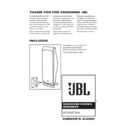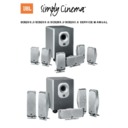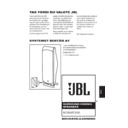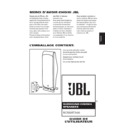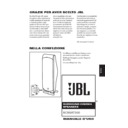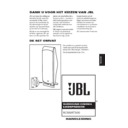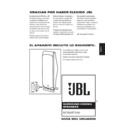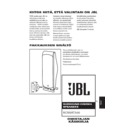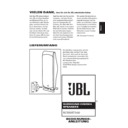JBL SCS 300 SAT (serv.man2) User Manual / Operation Manual ▷ View online
5
7 in order to avoid damage to
the Threaded Insert
the Threaded Insert
§
.
Such damage would not be
covered under the warranty.
covered under the warranty.
Step 7: Holding the Satellite
Speaker ¶ with both hands,
reinsert the ball portion of
the Ball and Shaft £ into the
Attachment Plate ¢.
Speaker ¶ with both hands,
reinsert the ball portion of
the Ball and Shaft £ into the
Attachment Plate ¢.
Step 8: Hand-tighten the
Molded Nut ™ while posi-
tioning the speaker for the
desired orientation.
If the Molded Nut
Molded Nut ™ while posi-
tioning the speaker for the
desired orientation.
If the Molded Nut
™
is diffi-
cult to tighten by hand, insert
the Metal Bar
the Metal Bar
∞
into one of
the holes in the outer edge of
the Molded Nut
™
and use
the bar as a lever. Be careful
not to cross-thread.
The swiveling ball enables
you to aim the speaker to one
side or the other, or to tilt it
up or down. Although stereo
imaging may be improved
by aiming the front speakers
toward the listening position,
especially for music selec-
tions, the surround speakers
are intended to provide a dif-
fuse, ambient sound that is
best achieved by aiming the
speakers straight out from
the wall. Aiming the surround
speakers toward the listening
not to cross-thread.
The swiveling ball enables
you to aim the speaker to one
side or the other, or to tilt it
up or down. Although stereo
imaging may be improved
by aiming the front speakers
toward the listening position,
especially for music selec-
tions, the surround speakers
are intended to provide a dif-
fuse, ambient sound that is
best achieved by aiming the
speakers straight out from
the wall. Aiming the surround
speakers toward the listening
position may ruin the inten-
ded effect by calling too
much attention to the infor-
mation in those channels.
ded effect by calling too
much attention to the infor-
mation in those channels.
Step 9: Once the speaker’s
orientation has been final-
ized, insert the Metal Bar ∞
into one of the holes in the
outer edge of the Molded Nut
™ and tighten the Molded
Nut ™ securely. Keep the
Metal Bar ∞ in a safe place
in the event that you decide
to adjust the speaker’s orien-
tation in the future.
orientation has been final-
ized, insert the Metal Bar ∞
into one of the holes in the
outer edge of the Molded Nut
™ and tighten the Molded
Nut ™ securely. Keep the
Metal Bar ∞ in a safe place
in the event that you decide
to adjust the speaker’s orien-
tation in the future.
CONNECTION TIPS
SPEAKER CONNECTIONS
Separate and strip the
ends of the speaker wire
as shown. The wires supplied
with the system may already
be stripped and tinned for
easy insertion into the
speaker terminals. You may
need to separate the two
conductors further in order to
thread them through the shelf
stand or floor stand adaptor.
Speakers and electronics ter-
minals have corresponding
(+) and (–) terminals. Most
manufacturers of speakers
and electronics, including
ends of the speaker wire
as shown. The wires supplied
with the system may already
be stripped and tinned for
easy insertion into the
speaker terminals. You may
need to separate the two
conductors further in order to
thread them through the shelf
stand or floor stand adaptor.
Speakers and electronics ter-
minals have corresponding
(+) and (–) terminals. Most
manufacturers of speakers
and electronics, including
JBL, use red to denote the (+)
terminal and black to denote
the (–) terminal.
terminal and black to denote
the (–) terminal.
The (+) lead of the speaker
wire is noted with a stripe. It
is important to connect both
speakers identically: (+) on
the speaker to (+) on the
amplifier and (–) on the
speaker to (–) on the ampli-
fier. Wiring “out of phase”
results in thin sound, weak
bass and a poor stereo
image.
wire is noted with a stripe. It
is important to connect both
speakers identically: (+) on
the speaker to (+) on the
amplifier and (–) on the
speaker to (–) on the ampli-
fier. Wiring “out of phase”
results in thin sound, weak
bass and a poor stereo
image.
With the advent of multichan-
nel surround sound systems,
connecting all of the speak-
ers in your system with the
correct polarity remains
equally important in order to
preserve the proper ambi-
ence and directionality of the
program material.
nel surround sound systems,
connecting all of the speak-
ers in your system with the
correct polarity remains
equally important in order to
preserve the proper ambi-
ence and directionality of the
program material.
To connect the supplied
speaker wires to the satellite
and center speaker termi-
nals, press the red or black
plastic cap for the desired
terminal, insert the bare end
of the wire into the hole
below the cap and release
the cap. Gently tug on the
wire to make sure that it is
fully inserted.
speaker wires to the satellite
and center speaker termi-
nals, press the red or black
plastic cap for the desired
terminal, insert the bare end
of the wire into the hole
below the cap and release
the cap. Gently tug on the
wire to make sure that it is
fully inserted.
6
Connect each speaker to
the corresponding speaker
terminals on your receiver
or amplifier.
the corresponding speaker
terminals on your receiver
or amplifier.
If you are using a subwoofer,
follow the directions in that
owner’s guide to connect and
configure it.
follow the directions in that
owner’s guide to connect and
configure it.
Configure your receiver or
processor to reflect the cor-
rect number of speakers in
your system. If you have
added one SCSSAT300
speaker to a 5.1-channel sys-
tem, reconfigure it as
a 6.1 system. If you have
added two SCSSAT300
speakers to a 5.1-channel
system, reconfigure it as
a 7.1 system.
processor to reflect the cor-
rect number of speakers in
your system. If you have
added one SCSSAT300
speaker to a 5.1-channel sys-
tem, reconfigure it as
a 6.1 system. If you have
added two SCSSAT300
speakers to a 5.1-channel
system, reconfigure it as
a 7.1 system.
The front left, front right, cen-
ter and rear speakers should
all be set to “Small.” If your
receiver allows you to set the
crossover frequency
between the subwoofer and
the main speakers, select
100Hz or the setting that is the
closest frequency below it.
ter and rear speakers should
all be set to “Small.” If your
receiver allows you to set the
crossover frequency
between the subwoofer and
the main speakers, select
100Hz or the setting that is the
closest frequency below it.
SYSTEM CONNECTION
– +
– +
– +
– +
– +
– +
– +
– +
– +
Receiver
Subwoofer
Out
Left
Front
Left
Surround
– +
Right
Front
Right
Surround
Subwoofer
Center
Surround Back
Left
– +
Surround Back
Right
LFE In
Right Surround
Right Front
Left Surround
Left Front
Center
– +
Surround Back
Left
– +
– +
Surround Back
Right
7
If there is no sound from any
of the speakers:
of the speakers:
• Check that receiver/ampli-
fier is on and a source is
playing.
fier is on and a source is
playing.
• Check all wires and con-
nections between receiver/
amplifier and speakers. Make
sure all wires are connected.
Make sure none of the
speaker wires are frayed, cut
or punctured, or touching
each other.
nections between receiver/
amplifier and speakers. Make
sure all wires are connected.
Make sure none of the
speaker wires are frayed, cut
or punctured, or touching
each other.
• Review proper operation of
your receiver/amplifier.
your receiver/amplifier.
If there is no sound coming
from one speaker:
from one speaker:
• Check the “Balance” control
on your receiver/amplifier.
on your receiver/amplifier.
• Check all wires and con-
nections between receiver/
amplifier and speakers. Make
sure all wires are connected.
Make sure none of the
speaker wires are frayed, cut
or punctured, or touching
each other.
nections between receiver/
amplifier and speakers. Make
sure all wires are connected.
Make sure none of the
speaker wires are frayed, cut
or punctured, or touching
each other.
• In Dolby Digital or DTS
modes, make sure that the
receiver/processor is config-
ured so that the speaker in
question is enabled.
modes, make sure that the
receiver/processor is config-
ured so that the speaker in
question is enabled.
• Turn off all electronics
and switch the speaker in
question with one of the
other speakers that is work-
ing correctly. Turn everything
back on, and determine
whether the problem has fol-
lowed the speaker, or has
remained in the same chan-
nel. If the problem is
and switch the speaker in
question with one of the
other speakers that is work-
ing correctly. Turn everything
back on, and determine
whether the problem has fol-
lowed the speaker, or has
remained in the same chan-
nel. If the problem is
in the same channel, the
source of the problem
is most likely with your
receiver or amplifier, and you
should consult the owner’s
manual for that product for
further information. If the
problem has followed the
speaker, consult your dealer
for further assistance or, if
that is not possible, visit
www.jbl.com.
source of the problem
is most likely with your
receiver or amplifier, and you
should consult the owner’s
manual for that product for
further information. If the
problem has followed the
speaker, consult your dealer
for further assistance or, if
that is not possible, visit
www.jbl.com.
If the system plays at low
volumes but shuts off as
volume is increased:
volumes but shuts off as
volume is increased:
• Check all wires and con-
nections between receiver/
amplifier and speakers. Make
sure all wires are connected.
Make sure none of the
speaker wires are frayed, cut
or punctured, or touching
each other.
nections between receiver/
amplifier and speakers. Make
sure all wires are connected.
Make sure none of the
speaker wires are frayed, cut
or punctured, or touching
each other.
• If more than one pair of
main speakers is being used,
check the minimum imped-
ance requirements of your
receiver/amplifier.
main speakers is being used,
check the minimum imped-
ance requirements of your
receiver/amplifier.
If there is low (or no) bass
output:
output:
• Make sure the connections
to the left and right “Speaker
Inputs” have the correct
polarity (+ and –).
to the left and right “Speaker
Inputs” have the correct
polarity (+ and –).
• If your system includes a
subwoofer, check its opera-
tion and the configuration of
your receiver or processor.
If your system has no sub-
woofer, consider adding a
powered subwoofer.
subwoofer, check its opera-
tion and the configuration of
your receiver or processor.
If your system has no sub-
woofer, consider adding a
powered subwoofer.
If there is no sound from
the surround speakers:
the surround speakers:
• Check all wires and con-
nections between receiver/
amplifier and speakers. Make
sure all wires are connected.
Make sure none of the
speaker wires are frayed, cut
or punctured, or touching
each other.
nections between receiver/
amplifier and speakers. Make
sure all wires are connected.
Make sure none of the
speaker wires are frayed, cut
or punctured, or touching
each other.
• Review proper operation of
your receiver/amplifier and
its surround sound features.
your receiver/amplifier and
its surround sound features.
• Make sure the movie or
TV show you are watching
is recorded in a surround
sound mode. If it is not, check
to see whether your
receiver/amplifier has other
surround modes you may use.
TV show you are watching
is recorded in a surround
sound mode. If it is not, check
to see whether your
receiver/amplifier has other
surround modes you may use.
• In Dolby Digital or DTS
modes, make sure your
receiver/processor is config-
ured so that the surround
speakers are enabled. When
five satellites are in use,
remember to configure your
receiver or processor for
6.1-channel operation,
and when six satellites are
in use, configure your
receiver or processor for 7.1-
channel operation.
modes, make sure your
receiver/processor is config-
ured so that the surround
speakers are enabled. When
five satellites are in use,
remember to configure your
receiver or processor for
6.1-channel operation,
and when six satellites are
in use, configure your
receiver or processor for 7.1-
channel operation.
• Review the operation of
your DVD player and the
jacket of your DVD to make
sure that the DVD features
the desired Dolby Digital or
DTS mode, and that you have
properly selected that mode
using both the DVD player’s
menu and the DVD disc’s
menu.
your DVD player and the
jacket of your DVD to make
sure that the DVD features
the desired Dolby Digital or
DTS mode, and that you have
properly selected that mode
using both the DVD player’s
menu and the DVD disc’s
menu.
TROUBLESHOOTING
Declaration of Conformity
We, Harman Consumer Group International
2, route de Tours
72500 Chateau-du-Loir
France
72500 Chateau-du-Loir
France
declare in own responsibility that the products described in this
owner’s manual are in compliance with technical standards:
owner’s manual are in compliance with technical standards:
EN 61000-6-3:2001
EN 61000-6-1:2001
EN 61000-6-1:2001
Gary Mardell
Harman Consumer Group International
Chateau-du-Loir, France 04/04
Maximum Recommended Amplifier Power
100 Watts
100 Watts
Power Handling (Continuous/Peak)
50W/200W
50W/200W
Nominal Impedance 8 Ohms
Sensitivity 88dB @ 1 Watt/1 meter
Frequency Response 100Hz – 20kHz (–6dB)
Tweeter
One 13mm (1/2") titanium-laminate dome, video-shielded
One 13mm (1/2") titanium-laminate dome, video-shielded
Midrange
Dual 75mm (3") drivers, video-shielded
Dual 75mm (3") drivers, video-shielded
Dimensions (H x W x D) (not including shelf stand)
292mm x 102mm x 89mm (11-1/2" x 4" x 3-1/2")
292mm x 102mm x 89mm (11-1/2" x 4" x 3-1/2")
Weight 1.4kg (3 lb)
SPECIFICATIONS
All features and specifications are subject to change
without notice.
without notice.
*Trademarks of Dolby Laboratories.
DTS is a registered trademark of Digital Theater Systems, Inc.
DESIGN GOAL:
Bring the thrill of live performance
and movie sound to the home environment by calling on JBL’s
professional engineering leadership.
professional engineering leadership.
SATELLITE TYPE:
Titanium-laminate-dome tweeter,
sealed enclosure
PROFESSIONAL REFERENCE:
Cinema
Loudspeaker Series
OWNER’S GUIDE
PRODUCT LINE:
MODEL:
SCSSAT300
SURROUND CINEMA
SPEAKERS
SPEAKERS
© 2004 Harman International Industries, Incorporated
JBL is a registered trademark of
Harman International Industries, Incorporated.
Harman International Industries, Incorporated.
Part No.406-000-00957
PRO SOUND
COMES HOME
COMES HOME
™
Display

